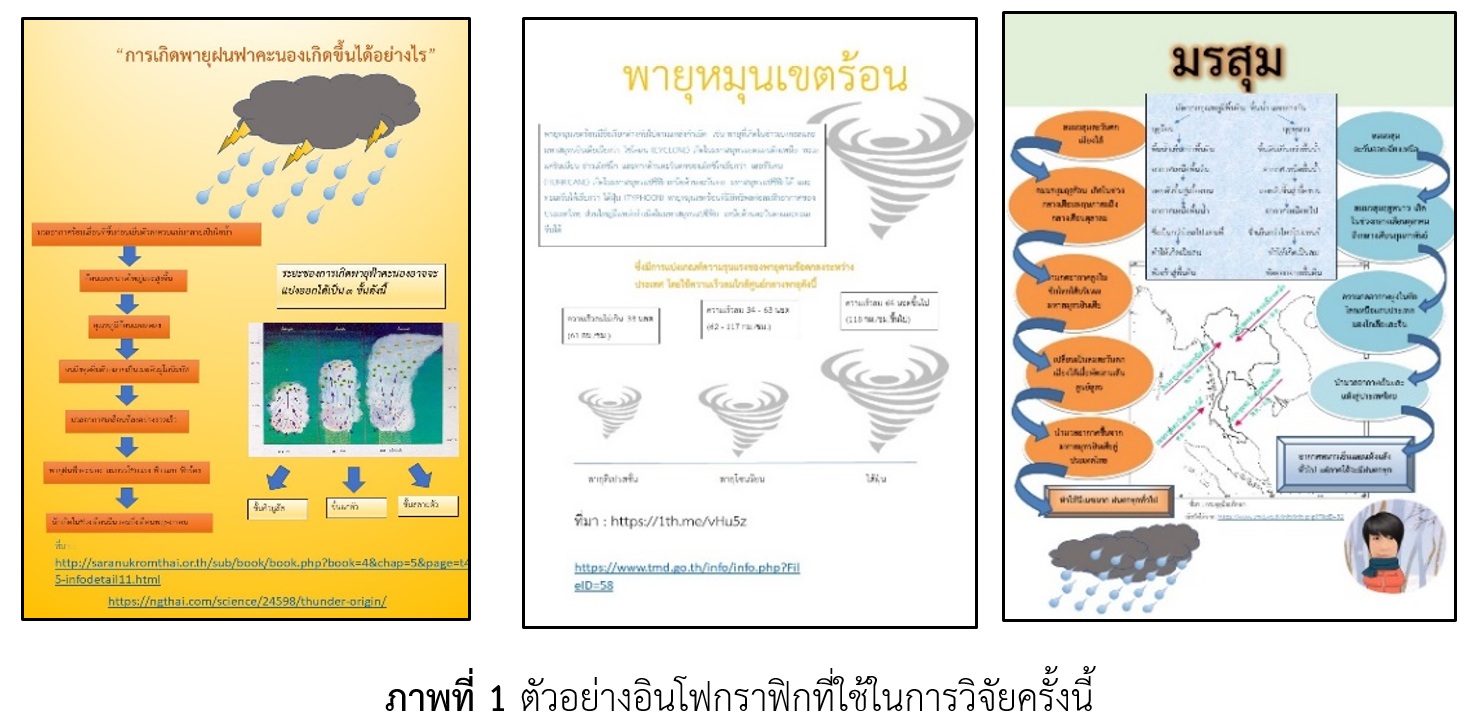Effect of Inquiry Learning In-cooperated with the Use of Infographics on the Scientific Explanation Ability of Ethnic group Students
Main Article Content
Abstract
The purpose of this research was to study the effects of inquiry learning in-cooperated with the use of infographic on the ability to create scientific explanations of ethnic students on the topic “the weather”. The study groups in this research were 6 students in Mathayomsuksa 1 at a school in Omkoi District, Chiang Mai Province during the 2nd-semester in academic year 2019. The research methods used for analyzing data was qualitative with descriptive statistic. The research instruments consisted of 7 lesson plans, the interview protocol to assess of scientific explanation ability that comprised of 4 core questions. The interview transcribed data was analyzed by level in each of the 3 components of the scientific explanation including claims, evidence, reasoning in percentage. The research results showed that most students were able to create scientific explanations at a good level by 66.67 percent, a very good level of 16.67 percent, and needs for improvement level at 16.67 percent. Consideration of each component, Ability to identify the claim was the students’ highest score with 77.08 percent, followed by ability to use evidence, the students’ score is 54.71 percent and the reasoning component, the lowest of the students’ score is 41.67 percent. The research findings indicated that inquiry learning in-cooperated with the use of infographics promoted the students’ formulating of scientific explanation on given questions. The additional aspect to be emphasized was the connection between scientific explanation to evidence using scientific reasoning.
Article Details
The Journal of Science and Science Education (JSSE) retain the right of all articles published in JSSE. The coresponding author or the authorized person on behalf of the authors must send the complete Copyright Transfer Form to JSSE before any article get published in JSSE.
Copyright Transfer Form
The JSSE request the coresponding author or the authorized person on behalf of the authors upload the manuscript under the together with the Copyright Transfer Form under the supplementary data. The guidline for uploading both manuscript and Copyright Transfer Form is shown below:
1. Upload the manuscript in the sub-menu, Article Component > Article Text.
2. Upload the the Copyright Transfer Form in the sub-menu, Article Component > Other.
Download Copyright Transfer Form
References
Allen, S. (1997). Using scientific inquiry activities in exhibit explanations. Science education, 81(6), 715-734.
Bybee, R. W. (2006). Scientific inquiry and science teaching. In L. B. Flick & N. G. Lederman (Eds.), Scientific inquiry and nature of science (pp. 1-14). Springer, Dordrecht.
Chamrat, S. (2019). The design and development of stem for life, economy and society materials and learning activity. Veridian E-Journal, Silpakorn University (Humanities, Social Sciences and arts), 12(2), 1150-1170.
Chaowakeratipong, N. (2019). Enhancing the ability in constructing scientific explanations of learners by using the inquiry teaching Method (in Thai). STOU Education Journal, 12(1), 40-54.
Gebre, E. (2018). Learning with multiple representations: Infographics as cognitive tools for authentic learning in science literacy. Canadian Journal of Learning and Technology, 44(1).
Institute for the Promotion of Teaching Science and Technology. (2016). Summary of research results of the TIMSS 2015 project (in Thai). Retrieved 2 April 2019, from Trends in International Mathematics and Science Study: http://timssthailand.ipst.ac.th/timss/reports.
Lomklang, S., Tanahoung, C., Wuttisela, W. and Wutiprom, S. (2021). The study of mental model through drawing about solar system for grade-4 students (in Thai). Journal of Science and Science Education, 4(1), 107-117.
McNeill, K. L. and Krajcik, J. (2008). Inquiry and scientific explanations: Helping students use evidence and reasoning. In Luft, J., Bell, R. L., & Gess-Newsome, J. (Eds.), Science as Inquiry in the Secondary Setting (pp.121-134). NSTA Press.
Metz, K. (2000). Young children’s inquiry in biology: Building the knowledge bases to empower independent inquiry. In Minstrell, J. and van Zee, E. (Eds.), Inquiring into Inquiry Learning and Teaching in Science (pp. 371-404). Washington, D.C: AAAS.
Ministry of Education. (2017). Indicators and concepts in science subject (revision B.E.2560) according to basic education core curriculum B.E. 2551 (in Thai). Bangkok: Chumnumsahakorn Karnkaset.
National Research Council. (1996). National science education standards. National Academies Press.
National Science Technology and Innovation Policy Office. (2015). Background of the institution (in Thai). Retrieved 7 April 2019, from http://www.sti.or.th/about.php?content_type=2.
Office for promotion of the learning society and the quality of youth. (2020). Infographic: the new storytelling tools (in Thai). Retrieved 20 March 2019, from http://www.qlf.or.th/Home/Contents/300.
O'donoghue, T. (2006). Planning your qualitative research project: An introduction to interpretivist research in education. Routledge.
Pananchai, K., Matarat, P., Tamuang, S. and Supasorn, S. (2018). Eleventh grade students’ conceptual understanding and mental models on chemical equilibrium from learning by using inquiry incorporated with predict-observe-explain technique (in Thai). Journal of Science and Science Education, 1(1), 49-60.
Ruiz-Primo, M. A., Li, M., Tsai, S. and Schneider, J. (2008). CRESST Report 733: Testing one premise of scientific inquiry in science classrooms: A study that examines student’s scientific explanation. Los Angeles: University of California.
Sakurada, J. (2015). Basic infographic (in Thai). Nonthaburi: DC Premier.
Samakoses, V. (2013). Infographics help with learning (in Thai). Retrieved 2 March 2019, from Bangkok Biz News: https://www.bangkokbiznews.com/blog/detail/490933.
Science Teachers’ Association of Ontario. (2006). Position paper: The Nature of Science, 1-2. Ontario: SCCAO Helping Science Happen.
Vanichvasin, P. (2015). Potentials of using Infographics in Enhancing the quality of Learning (in Thai). Panyapiwat Journal, 7(special), 227-240.
Wangthaphan, T., Chanchampa C. and Wonsawas, W. (2018). The study “lipid and protein” of grade 10 students’ by using 5e inquiry model to enhance scientific explanation skills (in Thai). Proceedings of 2nd of Suansunandha Rajabhat University (pp.346-353). Bangkok: Suan Sunandha Rajabhat University.
Worakhot, J., Chansawang, N. and Tabtimsai, C. (2018). Examining high school student-generated explanations on acid-base (in Thai). Proceedings of 4th Faculty of Information and Technology Rajabhat MahaSarakham University Research Conference (pp.49-55). Maha Sarakham: Rajabhat Maha Sarakham University.


